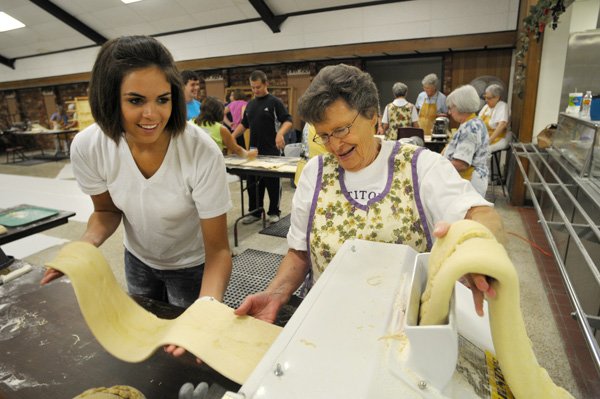TONTITOWN — Preparing pasta for the annual Tontitown Grape Festival requires a pinch of hard work, a dash of appreciation for tradition and a full measure of aptitude for plugging into a process that’s been honed over decades.
Volunteers were everywhere last Thursday in this oversized version of momma’s kitchen, but the 30 to 40 people moved like a well-choreographed dance routine.
At the starting point inside the parish hall of St. Joseph Catholic Church, some volunteers placed flour and eggs in an oversized mixer.
Others took it from there, kneading the resulting dough to ready it for placement in steadily humming electrical rollers. Still more volunteers manned a motorized cutter - the next step after the rollers.A handful of additional volunteers hung the resulting thin strips of spaghetti on wooden drying racks that spanned three full rows in theparish hall.
Thursday marked the first of multiple sessions to prepare more than 3,000 pounds of pasta for the112th Tontitown Grape Festival. Dinners will be served the eveningsof Aug. 5, 6 and 7. Proceeds are used for church programs.
It’s no wonder that the process moves like a coordinated effort. Volunteers have had decades to fi ne-tune their pasta-making. The dinners have been served to festivalgoers since 1932.
Preparing the pasta is all about tradition in this community settled by Italian immigrants in the late 1800s.
“A lot of these people have grown up (participating in the pasta-making),” said Jack Beckford, chairman of this year’s dinners.
His role requires no begging for volunteers. People want to show up to support the eff ort.
Some outsiders might consider it work, but he doesn’t get that sense from the volunteers.
“They’re having a pretty good time ...,” he said, looking around the crowded room of people chatting and laughing while they kept the lines moving.
“If it’s fun, it’s not work,” he opined.
He estimated they wouldprepare to feed some 8,000 diners during the three nights.
That’s a lot of flour - 4,000 pounds to be more precise for pasta and rolls.
Frances Franco has participated in the pasta-making for many years.
She’s pleased to be part of a tradition, and she relishesthe opportunity to catch up with others.
“You just get to see people that you don’t see all the time,” she said while manning one of the roller stations.
Previous generations had a harder job, she said. For example, the rollers once had to be hand-cranked.
But previous pasta-makersweren’t preparing for quite as many meals, she said.
She was working alongside Margie Ceola and Norma Deines.
The trio talked about the pasta as they worked. No secret ingredients are in the actual spaghetti. It’s just a combination of flour and eggs.
But when it comes to the red sauce, that’s a different story.
Its ingredients and preparation steps are a secret, they noted. The recipe’s one brought over from the old country, Ceola said.
Franco did offer a pointer for others preparing a homemade sauce.
Many just don’t cook it long enough, Franco said.
If it simmers for a long time, it will taste better, she advised.
Ceola said a slow cooker can be a good option. She and Franco theorized that cooking for a long time allows the spices to work their magic. Otherwise, the tomato paste overwhelms the other fl avors.
All three, along with Elizabeth Pianalto, Marty Taldo and Phyllis Hale, who were cutting and hanging pasta, agreed on the virtues of homemade red sauce.
If they dine out, they opt for Alfredo or some other sauce. In their estimation, restaurants’ red sauces can’t compare with homemade or Tontitown sauce.
“This is so much better,” Franco said.
Life, Pages 6 on 07/21/2010

